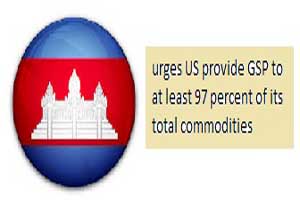
Cambodia PM urges US provide GSP to at least 97pc of its total commodities
YarnsandFibers News Bureau 2015-11-23 15:00:00 – Kuala LumpurThe US government currently provides duty-free status to over 5,000 types of products produced in Cambodia as part of its Generalized System of Preferences (GSP) Program. Washington granted Cambodia GSP trade privileges in 1996, along with Most Favoured Nation (MFN) status, which reduces tariffs on eligible products.
The combination of GSP and MFN status has allowed many Cambodian products to access the US market, making them more price competitive against the products of countries that do not enjoy the privileges.
At the third ASEAN-US Summit held in Kuala Lumpur on Saturday, Cambodian Prime Minister, Hun Sen said that his country would like to request that the US provide Generalized System of Preferences (GSP) to at least 97 percent of its total commodities, with tariff exemptions and quota-free [access], to least developed countries ( LDC) member states, in accordance with the previous agreement under the WTO framework.
He urged the policymakers in Washington to expand its preferential treatment of goods imported from least-developed countries (LDCs) including Cambodia by increasing the amount of goods permitted duty- and quota-free access to the US market.
The prime minister’s request refers to a 2005 ministerial meeting of the World Trade Organisation (WTO) in which developing nations pledged to provide extend duty-free and quota-free status to “at least 97 per cent of products originating from LDCs, defined at the tariff line level.
Economist Srey Chanthy said that the request is just to remind rich countries such as the US to implement the [WTO] agreement under a broad framework, which may not have been legal binding. Many developed economies, including Australia, Canada and the EU, have enacted special programs that extend duty- and quota-free treatment to all imports from LDCs with the exception of arms.
While the WTO decision to grant duty-free and quota-free access to 97 percent of products originating in LDCs appears potentially crippling to US domestic industries, the requirement is based on tariff lines and not on a trade-weighted basis. This loophole has allowed the US to exclude many of the chief export commodities of LDCs, such as sugar, cocoa and tobacco.
Ho Sivyong, director of the export-import department at the Ministry of Commerce, said that the US government’s GSP program covers most of the items that Cambodia exports, but excludes its largest export category by value: garments. However, Garments and textiles exported to the US are not eligible for the GSP scheme. They are covered under the MFN scheme, which requires importers to pay a tariff of around 10-15 percent.
While Sivyong said that he did not know how many of Cambodia’s tariff lines were covered by the GSP, he expects the US will continue to find ways to exclude garments from the programme.
If the US were to extend its GSP scheme to cover 97 percent of all commodities, it could help Cambodia to export more agricultural and other products to the US.
However, according to Sivyong, garments and textiles are in the remaining 3 percent that the US will not include in the GSP.
In 2014, Kingdom’s garment and footwear exports to the US reached $1.8 billion. According to the Garment Manufacturers Association in Cambodia, total exports to the US represents about 63 percent.
Market Intelligence
Ask for free sample Report

experience
Customer Base
dedicated team
Countries Served Worldwide









